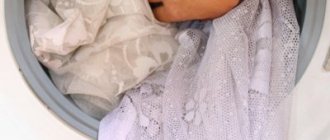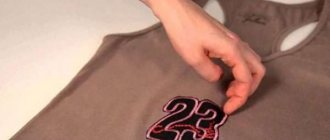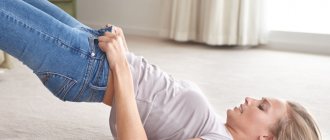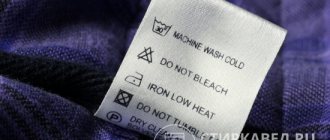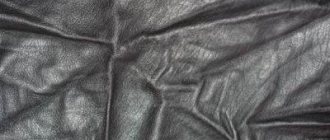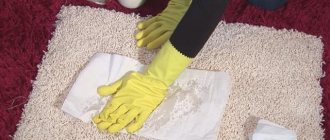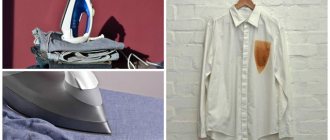Another original method is to run the sheet through the printer without printing on it. The device will eliminate light creases. However, this method is only applicable if the paper format is suitable for the printer. To straighten wrinkled paper, do not use a straightening iron, curling iron or hair dryer! Otherwise, you will irreversibly damage the document or notebook.
If the paper is very wrinkled, you can smooth it out using a press and an iron. Thus, you will smooth out any document, sheet, notepad and notebook, banknote and even wrapping paper. In addition, such methods are also suitable for smoothing files. Let's find out how to do this.
How to straighten paper using steam
Hot steam effectively smoothes paper sheets. But due to its high temperature, the material may deteriorate. Moisture will also negatively affect the quality of the paper.
It is recommended to steam crumpled paper through a steam generator or iron. In both cases, it is necessary to pass the steam through a thick towel so that the document is not permanently damaged and does not become wet.
You can steam a piece of paper over boiling water in a saucepan. To do this, you need to spread a thick towel over it and put a sheet on it. You can also straighten individual wrinkled sections of a paper document by holding them over the spout of a boiling kettle.
It is important not to hold the leaf too close to the spout itself. The steam will quickly cause the document to become wet and tear. Excess moisture may cause ink to bleed on the paper. It is recommended to keep the leaf at least 10 cm from the edge of the teapot spout.
What kind of water can be poured into the tank?
Any household appliance needs constant care and respect. One of the simplest and most important rules for operating any iron is to use high-quality and correct water, which is poured into the tank. The most common types are:
- Boiled. This liquid should absolutely not be used. Boiling is a good way to clean, but it's still not suitable for smoothing.
- Melted. This liquid contains organic substances that can affect both the performance of the device and the appearance of stains on clothing. So it is better to refrain from using it.
- Distilled. This liquid is suitable for smoothing. The only downside is that it requires a high temperature to boil. So you can mix distilled and tap water in a 1:2 ratio and pour this mixture.
- Special. It was produced specifically for ironing machines. All impurities and salts have been removed from such a liquid; it can be used without harm to the device.
How to straighten a piece of paper with an iron
Under the influence of high temperatures, crumpled paper sheets are smoothed out much better. But the iron can damage thin paper. It can also cause the material and ink on it to fade.
To straighten a crumpled piece of paper with an iron, you must follow the following recommendations:
- First hold the sheet for several hours under a heavy object.
- Cover the paper with a clean, thick cloth.
- Turn on the iron to minimum temperature and heat it up.
- Iron the fabric underneath the paper sheet. It is enough to do this for a minute.
- If after ironing the paper remains wrinkled, then it is necessary to repeat the procedure, slightly increasing the heating temperature of the iron.
When smoothing a sheet of paper, it is recommended to choose a thick terry towel as a lining material. You should not straighten wrinkled sheets of important documents and passports using this method.
Preventing the appearance of folds and creases
To ensure that the veil does not lose its beautiful appearance before the bride shines in front of the groom and her closest people, you need to follow some recommendations. Direct ironing alone will not be enough to ensure that the veil retains its appearance until the wedding. You need to learn how to store it correctly. Simply putting it in a closet with other things is not a suitable option. This way the veil will become unusable, and creases and folds will appear on it again, which are difficult to remove. Several ways have been developed to preserve an ironed veil until the wedding:
- covers for a wedding dress - if space allows, the veil is placed in a cover for the dress, so it will retain its freshness;
- special case - for a decorative veil of a large size or with a lot of beautiful additional details, a case is made separately;
- homemade bag - great if you have a sewing machine in the house - you can sew the cover yourself in a few minutes in the manner of a regular duvet cover, but smaller in size; in extreme cases, use plastic storage bags.
Only completely dry items are placed in bags or cases. If you put something wet inside, it is more likely to wrinkle.
Source
Straightening with a printer
This device can slightly smooth out wrinkled paper. However, the printer will not be able to straighten it completely. Also, the device will not remove creases from the sheet.
It is enough to pass the wrinkled paper through the printer once or several times. To do this, you need to open a blank sheet in Word format on the desktop of your laptop or computer and click on print.
Steam
You can iron things without an iron using steaming. Steam will perfectly straighten out all the wrinkles on thin fabric, but since the procedure is not quick, it is best to steam at night. You will be very lucky if, in addition to an iron, you have a steam generator in your household, but not everyone has this expensive device. Therefore, for steaming using improvised means, consider the following step-by-step instructions:
- Place a wide basin in the bathtub and fill it with water so hot that steam emanates from it.
- Install a structure above the basin that allows you to hold things above the steam. This could be a clothesline or a repositioned shower curtain bar.
- Hang the items to be straightened for 30 minutes.
- The item will get wet and begin to straighten out.
- Place clothes on hangers and let dry completely.
Other methods using improvised means
If you don’t have an iron, steam generator or printer, you can straighten a sheet of paper using improvised means. This could be an iron mug, a damp towel, a home mattress, or a lamp. If used correctly, you can smooth out the paper sheet using a curling iron or hair curling iron.
Hot iron mug
Metal objects work well to straighten crumpled paper. If you heat them up, the effect will be even better. It is enough to fill a clean steel or enamel mug with boiling water and place it on the wrinkled area of the sheet. It is recommended to keep the container on it until the water cools completely.
Wet towel
If you moisten the paper a little, it can smooth out well. However, you should not cover it with a towel that is too wet. It is enough to use a slightly dried cotton product. The towel must be placed on a paper sheet and left for an hour or a little more.
Spray
This method is in many ways identical to the previous option with a wet towel. If you apply a little water to the sheet through a spray bottle, it will smooth it out quite nicely as it evaporates. It is important not to apply too much water to the paper, as the material may be damaged and the writing on it may smudge. It is recommended to spray water only on heavily wrinkled areas of the leaf and wait until they dry completely.
Mattress
You can straighten the paper well using a mattress. It is necessary to place the crumpled sheet under it and leave it there overnight. Under strong pressure, the material will smooth out overnight. The mattress itself should press the paper sheet tightly. Otherwise, there will be no proper smoothing effect.
To prevent the paper sheet from getting dirty from the old mattress, it is recommended to put it in a document file.
Wet hand
This option is similar in effect to the method using a damp towel and spray. Only the human hand acts as a straightener. You need to wet your palm a little and apply it to the crumpled piece of paper.
Do not wet your hand too much. Excess moisture will cause the sheet to become very wet and may tear. Then an important document will be irretrievably damaged. It is recommended to lightly spray your palm with a spray bottle and apply it only to heavily wrinkled areas of the document. It is necessary to hold your hand for a while so that the paper is better saturated. After this, it is important to wait until the moisture from the surface of the paper has completely evaporated.
red-hot lamp
Using this method, you can straighten only a small piece of paper or a separate section of it. A hot lamp is not suitable for smoothing large sheets. This method is dangerous because it can cause a fire.
It is recommended to bring the crumpled piece of paper to the lamp and hold it over it for up to 20 seconds. It is important not to place the leaf too close to the light bulb. Due to the high temperature, the paper will instantly ignite and the document will be lost. Also, if you hold a sheet over a light bulb for a long time, a yellow or black spot will appear on it. It is necessary to keep the crumpled piece of paper at a distance of at least 10 cm from the hot light bulb.
Care tips and advice
There are pleated skirts that are not recommended by the manufacturer for ironing; you will need to carefully wash the product, dry it by hanging it on hangers, straightening each fold with your hands
It is important to take into account the recommendations placed on the sewn-in label of the product. If there is a crossed out iron symbol there, this means that the skirt cannot be ironed
If there is an iron icon with a steam image crossed out underneath it, the skirt must not be steamed.
To preserve the original appearance of the skirt, it is recommended to use special products designed for safe ironing. They contain special substances that prevent clothes from losing their original shape. A pleated cotton skirt can be starched. This will allow it to become a little stiffer and will not lead to severe creasing of the material. If all recommendations for caring for a pleated skirt are taken into account, it will look like new for a long time.
How to smooth files for paper
Another original method is to run the sheet through the printer without printing on it. The device will eliminate light creases. However, this method is only applicable if the paper format is suitable for the printer. To straighten wrinkled paper, do not use a straightening iron, curling iron or hair dryer! Otherwise, you will irreversibly damage the document or notebook.
If the paper is very wrinkled, you can smooth it out using a press and an iron. Thus, you will smooth out any document, sheet, notepad and notebook, banknote and even wrapping paper. In addition, such methods are also suitable for smoothing files. Let's find out how to do this.
Straightening wrapping paper
Wrapping paper is used to decorate gifts, so it should be beautiful, smooth and shiny. Creases and jams are unacceptable.
Ways to correct the situation:
- The gift paper is placed face down on a flat surface.
- Place a flat, dry sheet or clean cotton napkin on top.
- Pass the iron on a delicate setting over the fabric, without stopping in one place.
- After the procedure, do not take it out immediately, leave it to cool. If you take out a hot sheet, it will “pull off.” Damaged paper cannot be corrected.
The method is suitable for both craft packaging and glassine. Do not use water during the procedure, this will ruin the paper. It will roll into lumps or become more wrinkled.
Leveling the material on the edge of a flat surface will quickly help you deal with the problem: table, window sill, cabinet. A copy of the document is first made so that it can be restored if the result is negative.
Under pressure
The essence of the method is that a sheet of paper is smoothed out under the weight of the load.
The cargo can be:
- books;
- heavy equipment;
- pieces of furniture;
- sports equipment;
- other heavy objects.
Mode of application:
- First, you need to moisten the paper a little with clean water. Water will help smooth out damaged areas and soften the paper. It is convenient to do this by spraying water on it from a fine spray bottle, at a distance of about 40 cm. Another option is to carefully, so as not to tear it, walk over the sheet with a dampened and wrung out soft sponge. To moisten the sheet, you can place a damp, but not wet, towel on it for a short time.
- You need to act very carefully, because water can wash away the paint applied to the paper. It is better to spray water on the opposite side of the paper from the paint.
- After the sheet is wet, it is straightened by hand and placed between two pieces of highly absorbent material. These can be blotting pads, a paper napkin without embossing, felt and other options.
- After this procedure, the paper in absorbent material can be placed under the press.
- Next you need to be patient. Leave the paper for 12 hours, then check its condition. If it is still wet, replace the absorbent with a dry one. Even a heavily moistened sheet should dry out in three to four days.
- Lightly moisten the document with distilled water from a spray bottle at a distance of at least 30 centimeters. Or blot the sheet with a damp cloth;
- Remember that water will wash out chalk, water-based inks and watercolors. In this case, moisten the sheet from the back side;
- If the watercolor paper is wrinkled, you should not use water at all. Place dry sheets under the press;
- Place the crumpled paper between blotting sheets, wool felt or other material that absorbs moisture. It is better not to use paper towels, as text or drawings may be imprinted on the product;
- Place the resulting stack on a hard horizontal surface and smooth it out with your hands. Then place heavy objects on top. This could be a stack of books or other cargo;
- Leave the paper to dry completely. Check every day to see if the sheets are dry. Change absorbent materials as necessary. Slightly damp paper dries in one to two days, completely damp sheets take up to four days to dry.
Before drying and straightening a wet book, remove moisture from the pages using a white towel or napkin and separate the pages. Place the book half-open and place blotting paper between the sheets.
Leave in a well-ventilated area, you can turn on the fan. Monitor drying and, if necessary, carefully separate stuck pages.
Using a heavy load
Heaviness smooths out wrinkles. The cargo is:
- 3-4 copies of bulky and heavy books;
- massive equipment, interior items, furniture;
- Sports Equipment;
- flat metal parts.
After choosing the cargo, it is important to consider the nuances:
- To obtain the result, the leaf is moistened. A damp cloth, rag or fine spray will do.
- Moisten the back of the paper. There should be no paint, ink, pencil, or chalk on it.
- The napkin is used as a blotter and placed under the paper.
- Slightly moistened paper is placed under a weight and left to straighten for a day.
If the result is not satisfactory, the severity is left for the next 24-48 hours. The procedure will straighten severe creases.
A document with inscriptions and drawings printed on it must not be wetted. Allowed to straighten dry.
How to iron paper
There is another popular method for ironing paper - using an iron.
This is a riskier option than press drying. Even if you iron a crumpled sheet under the fabric, the folds will still remain visible.
When processing paper wet, folds are removed from it before ironing, but the colors may fade, or the sheet may not withstand the treatment and may tear. Therefore, it is necessary to act as carefully as possible.
The method of using the iron involves several simple steps.
- The crumpled paper must be carefully smoothed out with your hands and covered with a cloth or towel.
- The iron is turned on to the minimum temperature. Exposure to high temperatures may cause the sheet to yellow or become brittle.
- After heating the appliance, iron the sheet over the cloth or towel lying on it for one minute.
- Lift the towel and check the result. If the paper is not leveled, you need to increase the temperature slightly and repeat all the steps from the beginning. If the sheet is straightened, but very hot, spray it with clean water from a spray bottle and iron it again.
The risk of using this option is very high - you can ruin the document forever. Therefore, if you are not sure of the correct actions, it is better to try another recovery method.
Take a towel or thick cloth and a spray bottle with distilled water. Do not use tap water as it contains certain minerals that will make the sheets hard and brittle.
First you need to lay out the paper on the ironing board and straighten it with your hands. Cover the document with a towel or thick layer of cloth. Set the iron to the lowest temperature so as not to overdry the items and make the canvas brittle or yellowed.
Then you need to carefully smooth the crumpled paper with an iron through a towel or cloth. After a minute, check the result. If the sheet is not leveled, slightly increase the heat of the iron.
If the sheet gets too hot, moisten the back of the document with water from a spray bottle. Then the product must be gently ironed again. Repeat the procedure until you achieve the desired result.
Canvases after watercolors, after chalk and inks that are not resistant to moisture should not be wetted with water! Increase the heating temperature of the iron gradually and start with the lowest one. Otherwise, when the printed text is processed at a hot temperature, the latter will begin to melt. As a result, it will stick to the towel or fabric through which the document is ironed.
Do not use too much water when spraying, otherwise the text or design will float. Do not iron your passport or other document without a towel or cloth. Without this, the sheets will turn yellow and will not smooth out. It also increases the risk of ignition and fire.
How to starch correctly at home?
You can starch clothing items both in specialized studios and at home. The second option does not cause any particular difficulties and does not require serious labor costs.
Hot method
The essence of the hot method was described above. To starch a headdress you will need:
- Mix water and starch in proportions determined depending on the desired hardness.
- Heat the remaining water over the fire, bringing to a boil.
- Add the starch solution to boiling water and wait until the mixture thickens.
- Wait until the resulting paste has cooled (five minutes is enough).
There is another method that will require:
- Mix one tablespoon of rice starch with 200 milliliters of water.
- Bring 800 milliliters of milk to a boil.
- Gradually pour the starch solution into the hot milk.
- Immerse the headdress in the resulting composition for 20 minutes.
To add shine to the hat, it is recommended to add a pinch of salt to the above mixtures.
Cold method
This method is recommended for those who have not previously performed such a procedure. To give the headdress the required shape, you need to mix 1.5 tablespoons of starch and 500 milliliters of water at room temperature. The resulting solution is then applied to the product on both sides using a brush. After the procedure, the hat is left to dry.
Dry method
The dry (also known as military) method is used for knitted items. “Pure” starch should be applied to the hat, evenly covering each thread. After this, the headdress should be sprayed with water from a spray bottle. At the end of the procedure, the product must be covered with white paper to dry.
In the microwave
This original method speeds up the procedure. To achieve the desired result, you will need to mix 2 tablespoons of starch and a liter of water. The resulting solution is then poured into a container into which the product to be treated is placed. Next, the container is placed in the microwave for 5 minutes. The device must be set to full power. At the end, the headdress is left to dry.
Other methods
If the value of the document is high, it is better not to take risks and give it to specialists.
Restorers
To straighten a sheet of paper that is of particular value, you can use the services of archivists and restorers. They will help restore even old paper or paintings.
Professional moisturizing
Water, of course, helps smooth out and restore the structure of paper, but professionals know that it can also ruin the document forever. Therefore, before using methods on how to straighten a sheet of paper using water, it is better to try them on a draft.
The method is very dangerous at home - you can accidentally spill water on the paper, or mold may grow on it. Experts sometimes impregnate the sheet with special substances against fungi. But if you use them at home, there is a risk of ruining not only the document, but also your health.
Professional drying
You also need to dry the paper carefully, as it can shrink or ripple. In case of leveling it under a press, experts recommend clamping the document between two absorbent pads in a vice.
Professional smoothing
Securities can be given to specialists for restoration, for example, restorers or archivists.
They will help you cope with even the most difficult cases. They are armed with special compounds that help smooth out the paper and prevent mold from appearing on it. Specialists have professional presses that will help you get rid of deep creases.
However, their services are not free. The cost of complex document restoration starts from 4,000 rubles. The price depends on the amount of work to be done. Although sometimes it is cheaper to entrust the papers to a professional than to completely restore them.
How to iron paper
Take a towel or thick cloth and a spray bottle with distilled water. Do not use tap water as it contains certain minerals that will make the sheets hard and brittle.
First you need to lay out the paper on the ironing board and straighten it with your hands. Cover the document with a towel or thick layer of cloth. Set the iron to the lowest temperature so as not to overdry the items and make the canvas brittle or yellowed.
Then you need to carefully smooth the crumpled paper with an iron through a towel or cloth. After a minute, check the result. If the sheet is not leveled, slightly increase the heat of the iron.
If the sheet gets too hot, moisten the back of the document with water from a spray bottle. Then the product must be gently ironed again. Repeat the procedure until you achieve the desired result.
Canvases after watercolors, after chalk and inks that are not resistant to moisture should not be wetted with water! Increase the heating temperature of the iron gradually and start with the lowest one. Otherwise, when the printed text is processed at a hot temperature, the latter will begin to melt. As a result, it will stick to the towel or fabric through which the document is ironed.
Do not use too much water when spraying, otherwise the text or design will float. Do not iron your passport or other document without a towel or cloth. Without this, the sheets will turn yellow and will not smooth out. It also increases the risk of ignition and fire.
Warnings
It’s not difficult to straighten crumpled paper yourself. However, before you begin the procedure, you need to read the following important warnings:
You cannot iron paper without fabric. The paint may melt and stick to the surface of the iron or ironing board.- Do not wet the sheets too much. The thinner they are, the higher the risk of damage.
- Do not straighten the paper with a hair straightener or similar electrical equipment.
Their temperature is too high, so the document will be hopelessly damaged.
How to straighten paper under a press
- Lightly moisten the document with distilled water from a spray bottle at a distance of at least 30 centimeters. Or blot the sheet with a damp cloth;
- Remember that water will wash out chalk, water-based inks and watercolors. In this case, moisten the sheet from the back side;
- If the watercolor paper is wrinkled, you should not use water at all. Place dry sheets under the press;
- Place the crumpled paper between blotting sheets, wool felt or other material that absorbs moisture. It is better not to use paper towels, as text or drawings may be imprinted on the product;
- Place the resulting stack on a hard horizontal surface and smooth it out with your hands. Then place heavy objects on top. This could be a stack of books or other cargo;
- Leave the paper to dry completely. Check every day to see if the sheets are dry. Change absorbent materials as necessary. Slightly damp paper dries in one to two days, completely damp sheets take up to four days to dry.
If the paper is wet
When paper gets wet, it can ripple and wrinkle, losing its attractive appearance. Therefore, it is necessary to take measures to dry the material as quickly as possible. Wet paper without drying not only wrinkles, but also gradually becomes covered with mold. In addition, ink or paint will bleed when exposed to water.
Sort out the wet sheets and place them in a well-ventilated area, open the windows or use a fan to dry. To dry papers and folders, cover the items with blotting sheets or other absorbent materials. Leave the sheets in a well-ventilated area and change blotters regularly.
Dip sticky wet laminated paper or wet photographs into a container of clean water and carefully separate them in the water. Then place the items face up on a towel and leave them in a room with good air circulation until completely dry.
Features of working with tulle
Almost any veil is made from tulle. This is a rather capricious material that can break even with slight bending. Therefore, the veil wrinkles during transportation or storage, which leads to loss of its beautiful appearance. Tulle is a delicate material. It is quite lightweight, mesh and translucent. At the same time, its texture is hard, so if even a small wrinkle appears, it will be difficult to deal with it.
But besides this, there is another feature - tulle is very difficult to perceive high temperatures. As soon as you touch it with a very heated iron, the mesh will instantly crumble, leaving a burnt hole.
Tulle also requires preliminary soaking. This will save time on direct ironing, and if after soaking you hang the product in a well-ventilated area on the loops, then ironing may not be required at all. Soaking is carried out in warm water, you can add a couple of drops of softener for delicate fabrics.
It is important to pay attention to the equipment that will be used in the work. So, the surface of the iron should be:
- perfectly clean;
- no traces of stuck fabric;
- no cracks, chips or scratches.
When working with tulle, the iron must be set to the “Synthetic” mode. It differs from the usual one in the minimum heating temperature.
How to dry and level books
Before drying and straightening a wet book, remove moisture from the pages using a white towel or napkin and separate the pages. Place the book half-open and place blotting paper between the sheets.
Leave in a well-ventilated area, you can turn on the fan. Monitor drying and, if necessary, carefully separate stuck pages.
You can also use the extreme method of drying the book in the refrigerator. To do this, remove as much moisture as possible from the pages using a towel, napkin and blotters. Then place the book in a ziplock bag and seal.
There should be air left in the bag. Place the book in the freezer and leave for one to two weeks. By the way, you can also stretch your shoes using a freezer. For more information on what to do if your shoes are too small or too tight, see here.
Source
How to dry documents correctly?
Line every few pages with paper towels or blotting paper, place the book on a towel or newspaper, and point a fan at the open pages. Change the layers from time to time to dry the book as quickly as possible.
Interesting materials:
How to remove a program through the registry? How to remove a program if it is not in Programs and Features? How to remove a program if it is not in the list of installed programs? How to remove a program if it is not in the list? How to remove a program if it is not removed in the usual way? How to remove a program if it cannot be removed? How to delete a program if it is open in another program? How to delete a program if it is open? How to remove a program if it requires administrator rights? How to remove a program if it is running?

